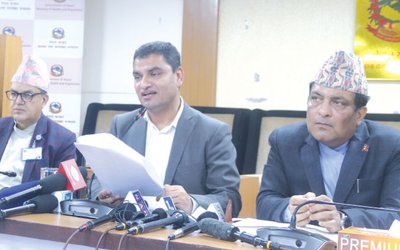
Handwashing with soap, when done correctly, is critical in the fight against the novel coronavirus disease (COVID-19), but millions of people have no ready access to a place to wash their hands, UNICEF said today.
However, Nepal situation is differnt. In Nepal, 33 per cent of urban population or around 3 in 10 people do not have access to handwashing with soap and water.
Handwashing is also key to protect health workers from infection and prevent the spread of COVID-19 and other infections in healthcare facilities. As the coronavirus response takes its toll on the health services in the affected countries, the practice of handwashing with soap is even more important in warding off common respiratory and diarrhoeal diseases.
In Nepal, 54 per cent health care facilities have no access to handwashing facilities at point of care. Availability of disinfectant at outpatient departments of health care facilities is only 59 per cent while availability of water in delivery rooms at health care facilities is 69 per cent.
According to UNICEF, in total, only 3 out of 5 people worldwide have basic handwashing facilities, according to the latest data. In Nepal, more than half of the population do not have access to handwashing with soap and water at households.
As the pandemic continues its spread, UNICEF is reminding the public of the importance of handwashing as a key prevention measure against COVID-19 and urging renewed efforts to provide access to this most basic of public health interventions around the world.
“Handwashing with soap is one of the cheapest, most effective things you can do to protect yourself and others against coronavirus, as well as many other infectious diseases. Yet for billions, even this most basic of steps is simply out of reach.” said Sanjay Wijesekera, UNICEF Director of Programmes. “It is far from a magic bullet. But it is important to make sure people know what steps they should take to keep themselves and their families safe, even as we continue our longstanding efforts to make basic hygiene and sanitation available to everyone.”
In many parts of the world, children, parents, teachers, healthcare workers and other members of the community do not have access to basic handwashing facilities at home, in healthcare facilities, schools or elsewhere. According to the latest estimates:
40 per cent of the world’s population, or 3 billion people, do not have a handwashing facility with water and soap at home. Nearly three quarters of the people in least developed countries lack basic handwashing facilities at home.
47 per cent of schools lacked a handwashing facility with water and soap affecting 900 million school-age children. Over one third of schools worldwide and half of schools in the least developed countries have no place for children to wash their hands at all. 16 per cent of healthcare facilities, or around 1 in 6, had no functional toilets or handwashing facilities at either points of care where patients are treated.
Urban populations are particularly at risk of viral respiratory infections due to population density and more frequent public gatherings in crowded spaces like markets, public transport or places of worship. People living in urban poor slums – the worst form of informal settlement – are particularly at risk. As a result, handwashing becomes even more important. Yet:
In sub-Saharan Africa, 63 per cent of people in urban areas, or 258 million people, lack access to handwashing. Some 47 per cent of urban South Africans, for example, or 18 million people, lack basic handwashing facilities at home with the richest urban dwellers nearly 12 times more likely to have access to handwashing facility.
In Central and South Asia, 22 per cent of people in urban areas, or 153 million people, lack access to handwashing. Nearly 50 per cent of urban Bangladeshis, for example, or 29 million people; and 20 per cent of urban Indians, or 91 million, lack basic handwashing facilities at home.
In East Asia, 28 per cent of urban Indonesians, or 41 million people, and 15 per cent of urban Filipinos, or 7 million people, lack basic handwashing facilities at home.
UNICEF works around the world to ensure children and their parents have access to appropriate handwashing facilities. Additionally, UNICEF promotes handwashing in over 90 countries, working with governments to develop handwashing policies, strategies and action plans. We also support national handwashing campaigns, including through mass media, through work with community health and outreach workers to make sure they promote handwashing, and through work with schools and teachers to teach children the importance of handwashing.
As part of their coronavirus response, UNICEF is also reminding the public of the best way to wash their hands properly:
- Wet hands with running water
- Apply enough soap to cover wet hands
- Scrub all surfaces of the hands – including back of hands, between fingers and under nails – for at least 20 seconds.
- Rinse thoroughly with running water
- Dry hands with a clean cloth or single-use towel
Photo: UNICEF Nepal
- Budget Session Of Federal Parliament Commencing On Friday
- Apr 24, 2025
- 19th Democracy Day Being Observed Today
- Apr 24, 2025
- Hot Wave Likely To Occur In Terai Belt Of Lumbini Province
- Apr 24, 2025
- UAE's Deputy Prime Minister In Kathmandu; Bilateral Meeting Today
- Apr 23, 2025
- PM Oli Condemns Terrorist Attack In India
- Apr 23, 2025















